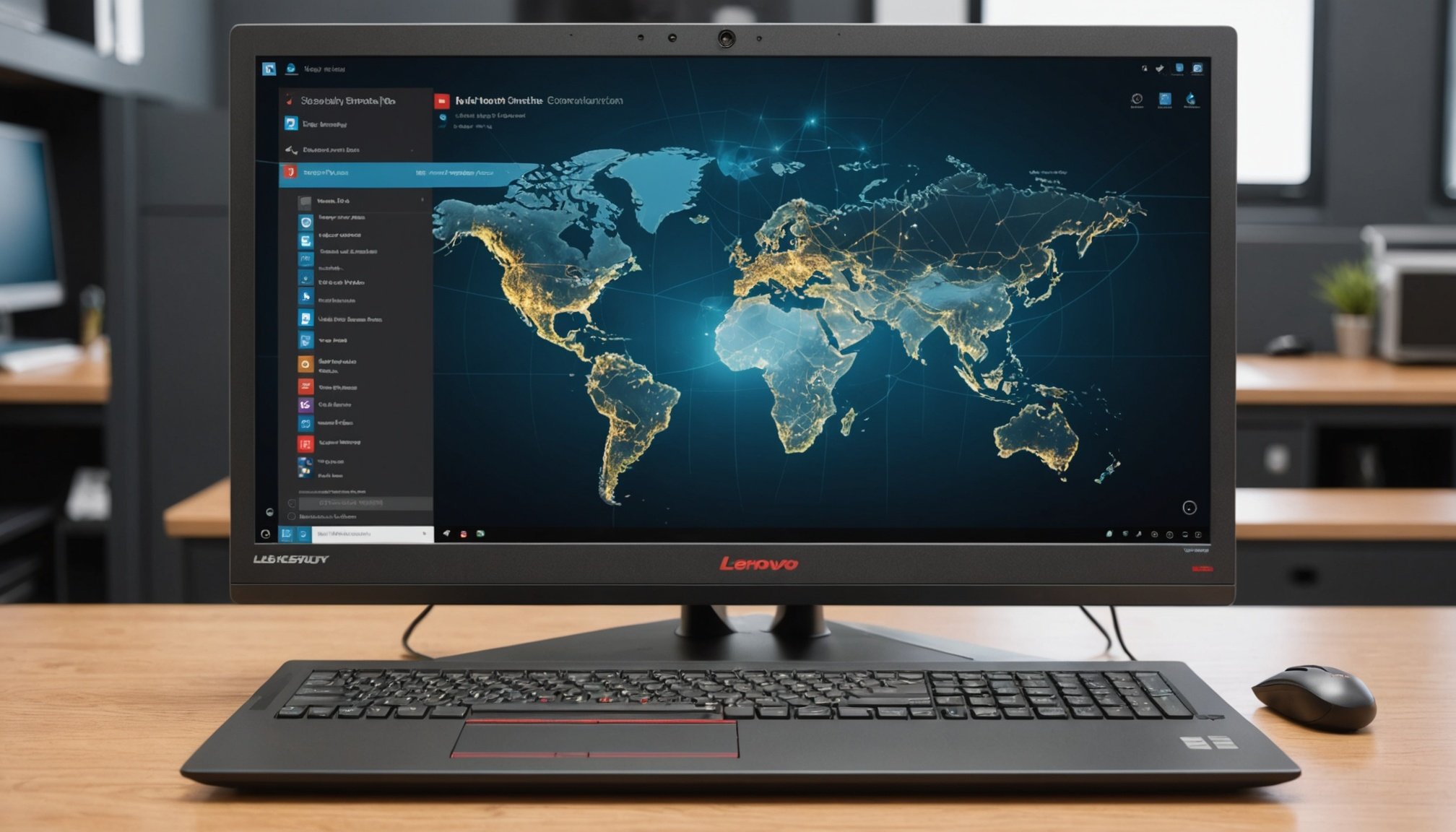Top Security Strategies to Protect Your Lenovo ThinkCentre M90n Remote Desktop Connection
In the era of remote work, ensuring the security of your remote desktop connections is more crucial than ever. The Lenovo ThinkCentre M90n, with its compact form factor and powerful Intel Core processors, is a popular choice for many professionals. However, its convenience and performance can be compromised if not properly secured. Here’s a comprehensive guide on the top security strategies to protect your Lenovo ThinkCentre M90n remote desktop connection.
Configuring Secure Remote Access
Secure remote access is the foundation of protecting your Lenovo ThinkCentre M90n. Here are some key steps to ensure your remote desktop connections are secure:
Using VPNs for Encrypted Connections
One of the most effective ways to secure your remote desktop connection is by using a Virtual Private Network (VPN). A VPN encrypts all data transmitted over the internet, making it virtually impossible for unauthorized parties to intercept and read your data.
- Install VPN Software: Choose a reputable VPN provider and install their software on your ThinkCentre M90n.
- Configure VPN Settings: Follow the provider’s instructions to configure the VPN settings. This typically involves entering your login credentials and selecting the desired server.
- Connect to the VPN: Before establishing a remote desktop connection, ensure you are connected to the VPN. This will encrypt all your internet traffic, including your RDP sessions.
Implementing Strong Authentication
Strong authentication is another critical aspect of securing your remote desktop connections. Here are some best practices:
Also read : Ultimate guide: mastering thermal throttling solutions for a high-performance gaming pc
- Use Multi-Factor Authentication (MFA): Enable MFA to add an extra layer of security beyond passwords. This can include methods like SMS codes, biometric authentication, or authenticator apps.
- Regularly Update Passwords: Ensure that all users change their passwords regularly. Use complex passwords that include a mix of uppercase and lowercase letters, numbers, and special characters.
- Limit Login Attempts: Configure your system to lock out users after a certain number of failed login attempts to prevent brute-force attacks.
Network Segmentation and Isolation
Network segmentation is a powerful strategy to enhance the security of your remote desktop connections. Here’s how you can implement it:
Creating VLANs for Device Isolation
Virtual Local Area Networks (VLANs) help in segregating devices into separate networks, each with its own set of security policies.
- Configure VLANs: Use your network hardware to create VLANs that isolate different types of devices. For example, you can have one VLAN for your remote desktop devices and another for guest devices.
- Apply Security Policies: Assign specific security policies to each VLAN. This could include firewall rules, access controls, and intrusion detection systems.
Managing Guest Networks
Guest networks are essential for separating external users from your internal network.
- Set Up Guest Networks: Create a separate network for guests that restricts access to sensitive internal resources.
- Limit Access: Ensure that guest networks do not have access to critical systems or data. Use firewalls and access controls to enforce these restrictions.
Utilizing Advanced Security Features
The Lenovo ThinkCentre M90n, along with Windows Pro, offers several advanced security features that can be leveraged to enhance security.
Intrusion Prevention and Detection
Intrusion Prevention Systems (IPS) and Intrusion Detection Systems (IDS) are crucial for real-time monitoring and threat mitigation.
- Enable IPS/IDS: Use built-in Windows security features or third-party software to enable IPS/IDS. These systems can identify and neutralize potential security breaches before they cause damage.
- Regularly Update Software: Ensure that your IPS/IDS software is regularly updated to protect against the latest threats.
Data Encryption
Data encryption is vital for protecting sensitive data both in transit and at rest.
- Use Encryption Tools: Utilize tools like BitLocker for disk encryption and SSL/TLS for encrypting data in transit.
- Encrypt RDP Sessions: Ensure that all RDP sessions are encrypted. Windows Remote Desktop Protocol (RDP) supports encryption by default, but it’s important to verify this setting.
Best Practices for Maintaining Security
Regular maintenance and adherence to best practices are key to maintaining the security of your remote desktop connections.
Regular Software Updates
Keeping your software up to date is crucial for patching vulnerabilities and protecting against the latest threats.
- Update Operating System: Regularly update your Windows operating system to ensure you have the latest security patches.
- Update Third-Party Software: Keep all third-party software, including VPN clients and security tools, updated.
Monitoring Logs and Activity
Monitoring logs and activity can help in identifying and responding to security incidents promptly.
- Use Log Monitoring Tools: Use tools like Windows Event Viewer or third-party log monitoring software to monitor system logs for suspicious activity.
- Set Up Alerts: Configure alerts for critical security events to ensure prompt action can be taken.
Practical Insights and Actionable Advice
Here are some practical insights and actionable advice to further secure your Lenovo ThinkCentre M90n remote desktop connections:
Educate Users
User education is a critical component of security. Ensure that all users understand the importance of security best practices.
- Conduct Regular Training: Organize regular training sessions to educate users on security best practices, such as using strong passwords, recognizing phishing attacks, and the importance of VPNs.
- Provide Resources: Make security resources available to users, such as guides on how to set up VPNs and use multi-factor authentication.
Use Secure Hardware
Using secure hardware can add an extra layer of security to your setup.
- Use Trusted Devices: Ensure that all devices connected to your network are trusted and secure. For example, use devices with built-in security features like TPM 2.0 and smart USB protection[2].
- Disable Unused Ports: Disable any unused USB ports or other interfaces to prevent unauthorized access.
Example Configuration Table
Example Configuration Table
Here is an example of how you might configure your Lenovo ThinkCentre M90n for secure remote desktop connections:
| Feature | Configuration | Description |
|---|---|---|
| VPN | Enable VPN | Use a reputable VPN provider to encrypt all internet traffic. |
| MFA | Enable MFA | Use multi-factor authentication to add an extra layer of security. |
| VLANs | Create VLANs | Segregate devices into separate VLANs with specific security policies. |
| Guest Network | Enable Guest Network | Create a separate network for guests with restricted access. |
| IPS/IDS | Enable IPS/IDS | Use built-in or third-party IPS/IDS to monitor and mitigate threats. |
| Data Encryption | Enable Encryption | Use tools like BitLocker and SSL/TLS to encrypt data in transit and at rest. |
| Software Updates | Regular Updates | Keep the operating system and all software up to date. |
| Log Monitoring | Enable Log Monitoring | Use tools to monitor system logs for suspicious activity. |
Quotes and Real-World Examples
Here are some quotes and real-world examples that highlight the importance of these security strategies:
- “Security is not just about protecting against threats; it’s about ensuring the integrity and availability of your data and systems.” – Cybersecurity Expert
- Example: A company that implemented VPNs and MFA for their remote desktop connections reported a significant reduction in unauthorized access attempts. This not only protected their sensitive data but also ensured compliance with regulatory requirements.
Securing your Lenovo ThinkCentre M90n remote desktop connection is a multifaceted task that requires a combination of advanced security features, best practices, and regular maintenance. By implementing VPNs, multi-factor authentication, network segmentation, and advanced security tools, you can significantly enhance the security of your remote work environment.
Remember, security is an ongoing process. Regularly updating software, monitoring logs, and educating users are crucial steps in maintaining a secure and reliable remote desktop connection. By following these strategies, you can ensure that your Lenovo ThinkCentre M90n remains a secure and powerful tool for your remote work needs.
In the words of a cybersecurity expert, “The best security strategy is one that is proactive, comprehensive, and continuously evolving to meet new threats.” By adopting these top security strategies, you can protect your Lenovo ThinkCentre M90n and ensure a secure and efficient remote work experience.
Best Practices for Remote Desktop Settings
Establishing robust Remote Desktop Best Practices is integral for optimizing security. It starts with configuring optimal Security Settings within the remote desktop application on Lenovo ThinkCentre M90n. Essential measures include enabling encryption to safeguard data and applying the principle of least privilege for user access.
Minimising vulnerabilities requires disabling unnecessary services. Features not in use should be turned off to reduce exposure. This approach significantly reduces the attack surface, making it harder for malicious entities to exploit any weak points.
Regular monitoring and maintenance of remote desktop settings are vital. Implementing real-time alerts helps detect any unauthorized access attempts, allowing for swift intervention. Additionally, schedule periodic reviews to align settings with evolving security standards and organisational needs.
Configuration Techniques play a crucial role in maintaining a secure environment. Setting password policies that require regular updates and strong authentication protocols ensures that access is limited to authorized personnel only. Combine these techniques with routine software updates to patch known vulnerabilities.
By systematically applying these practices, Lenovo ThinkCentre M90n users can create a robust line of defence against potential threats, ensuring secure remote desktop operations.



